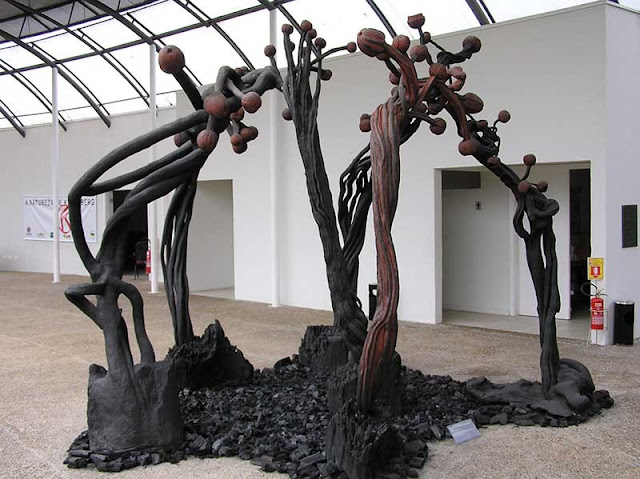"After the outbreak of the Second World War, Krajcberg, who came from a Jewish family, moved to the Soviet-occupied territories. In 1940, he commenced architecture studies in Leningrad. After the German invasion of the USSR, he joined the newly founded Polish Armed Forces in the East, where he was assigned to the sapper brigade. However, when the Polish army marched out, he remained in the Soviet Union. After the war, he learned that his entire family had been killed in a concentration camp, and he decided to not go back to Poland. He was accepted to the Academy of Fine Arts in Stuttgart and continued studying architecture under Willi Baumeister. After graduating in 1948 he moved to Paris, where he stayed for several years. He travelled a lot during that period, for example to Ibiza or Brazil, where he eventually decided to settle.
Between 1948 and 1954, he created his first sculptures and paintings expressing the direct exposure to nature and an attempt to make elements of the natural environment the sole material used in his works. In 1951, he participated in the 1st São Paulo Art Biennial. He moved to the Minas Gerais state in Brazil, to the Pico da Cata Branca cave in the Itabirito region. The locals called him ‘barbudo das pedras’ (the bearded stone man), as he lived an ascetic life in isolation, washing in the nearby river and sculpting in stone. Zé do Mato, the artist's exhibition assistant and technician, reminisces that Krajcberg ‘wanted to run away from humans, he resembled a wounded animal.’ He was saved by Brazilian nature, which ‘smiled at me and never asked where I came from and what my religion was. That is when I discovered life’, the artist confessed in an interview.
He later moved to the state of Paraná in southern Brazil, where he was hired as an engineer at a paper factory, but eventually moved to an isolated location in a forest and started painting (1952-1956). In 1956, he started living in Rio de Janeiro, where he shared a studio with Franz Weissmann (1911-2005), an Austrian artist, one of the major Brazilian sculptors of 20th century, and a student of August Zamoyski. One year later, Krajcberg obtained Brazilian citizenship and received the title of the country's best painter at the São Paulo Biennial. Beginning in the late 1950s, he often travelled to Europe, temporarily living in Paris, as well as Ibiza and Brazil. During that period, he created oil paintings and sculpted, drawing inspiration from Japanese art. In 1959, while in Ibiza, he started creating monochromatic reliefs decorated with natural pigments – Terras craqueladas (Cracked Earth). In 1964, he took part in the Venice Biennale, and afterwards returned permanently to Brazil, where he established an art studio in Cata Blanca and started creating sculptures and other spatial forms. That was when he created his first sculptures out of dead cedar trees. In 1970, he gained international recognition thanks to his sculptures made of charred wood. Krajcberg also started creating a new cycle titled Cutout Shadows, created out of specially trimmed vines.
Since 1972, he has been living in the south of the state of Bahia, in Nova Viscoça by the Atlantic Ocean, in a tree house suspended seven metres above the ground. It is also the location of his atelier, Sítio Natura. The artist went to Bahia upon an invitation from his dear friend, Zanine Caldas, who helped him build the house. He planted several thousand saplings of trees native to the Atlantic Forest on the grounds surrounding the house. Two pavilions, now housing over three hundred of his artworks, were also raised there. There are plans to create a museum to the artist, who since 1978, besides his artistic career, has also been pursuing an environmentalist path."(Author: Aleksandra Pluta culture.pl )











No comments:
Post a Comment